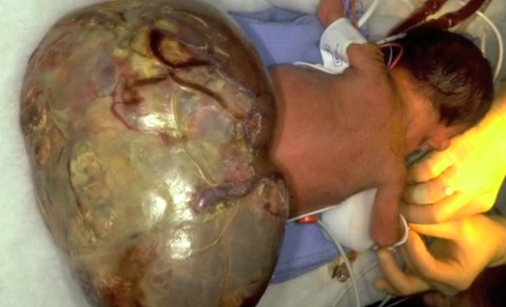
When Emma Shaw decided she wanted to start a family, she knew she faced a battle. Having been diagnosed with blocked fallopian tubes in her mid-20s, it was likely that IVF was her only option.
With her partner Tony Bailey, 40, supporting her she began a journey which around 36,000 women undertake in Britain every year.
She used her savings to fund the ?6,000 IVF cycle having discovered there was a two-year waiting list for NHS treatment in her area.
EXPRESS CASINO: GET a FREE BONUS OF UP TO ?150 NOW!
?The IVF was gruelling, both mentally and physically,? says Emma, now 39, from Morden, Surrey. ?Sometimes I?d be elated and other days I?d be scared and emotional.
?I hadn?t expected to feel so ill. I suffered hot sweats and had symptoms of ovarian hyperstimulation caused by the drugs I was taking to encourage egg production. It made me feel nauseous and the bloating was so painful.?
Around a third of women undergoing fertility treatment suffer from ovarian hyperstimulation syndrome (OHSS) which occurs when the ovaries overreact to fertility drugs causing swelling and sometimes leaking fluid into the abdominal cavity.
Most cases are mild but some women are hospitalised and it can even be fatal. Between 1999 and 2003 there were no adverse incidents of OHSS reported to the Human Fertilisation & Embryology Authority (HFEA), an independent body regulating fertility treatment but last year there were 114 cases.
Professor William Ledger, head of the Centre for Reproductive Medicine and Fertility at the Royal Hallamshire Hospital in Sheffield (jessopfertility.org.uk) and professor of obstetrics and gynaecology, says there are healthier IVF options. He says some women who do not wish to use fertility drugs or those who cannot tolerate them can opt for natural IVF. This was the method which led to the birth of Louise Brown, the world?s first test-tube baby in 1978.
The process involves working with the woman?s menstrual cycle, collecting the egg, fertilising it with her partner?s sperm and placing it back into the womb.
This works well when the male partner has fertility issues such as a low sperm, count rather than the woman.
Another gentle form of IVF, sometimes called mild IVF, involves a low dose of a stimulating hormone used for a shorter time than conventional IVF and works within the woman?s menstrual cycle. there is no suppression of hormones and no menopausal side effects. The aim is to collect between two and seven eggs.
Conventional IVF is the most popular choice. This involves daily injections to suppress hormones and then higher doses of the stimulating hormone to boost the number of eggs. The treatment can last up to five weeks and the aim is to produce as many viable eggs as possible.
Professor Ledger says women should be made more aware of natural and mild IVF. ?We achieve a high pregnancy rate with low multiple-birth rate by using a mild stimulation approach in most patients.
?It?s quicker, cheaper, safer, with half the rate of OHSS and more acceptable to patients. find any patient who has done both and I am sure she will say that the mild approach was better. to me its a no-brainer.?
E mma was devastated when she failed to get pregnant following three cycles of conventional IVF. each time she suffered OHSS.
With bills mounting to ?18,000 Emma and Tony, an IT consultant, were running short of money when they were told about mild IVF. they now have two children, Isabella, two, and Sophie who was born in November, following two cycles of mild IVF.
Professor Ledger says the success rates of mild IVF are similar to the conventional method if compared over the same time frame rather than per cycle. He says more cycles of mild IVF may be needed to achieve the same success but cycles are quicker and cheaper. It costs around ?2,750 for mild IVF and ?1,850 for natural cycle IVF.
Dr Geeta Nargund, medical director of Create Health Clinics in London (createhealth.org) and the president of the International Society for Mild Approaches in Assisted Reproduction (ISMAAR), says taking fewer drugs can suit older women. ?The evidence shows that women with low egg reserve and older women can be successful with a more natural approach using their naturally selected egg, as the drugs used to stimulate the ovaries don?t seem to benefit them anyway.
?Also a lot of women now undergo IVF treatment because their partner?s sperm is the cause of infertility and they are fertile women,? says Dr Nargund. ?These women are also given high doses of stimulating drugs. More are saying: ?why should I be treated as the infertile one? I don?t want all those drugs?.?
However, Adam Balen, professor of reproductive medicine and surgery at Leeds Centre for Reproductive Medicine, says natural IVF has a poor success rate and many clinics aim to give as low a dose of drugs as possible anyway.
?Mild IVF has become a buzzword,? says Professor Balen. ?But in my view it?s something of a misnomer as in reality, IVF clinics should be aiming to give the lowest dose of drugs that will achieve the desired response of the ovary.?
Former childminder Emma adds: ?I wished I had known about mild IVF before I put myself through three cycles of conventional IVF.
?I did have hot flushes and some hormonal changes but it was far less invasive, quicker, cheaper and it worked.?